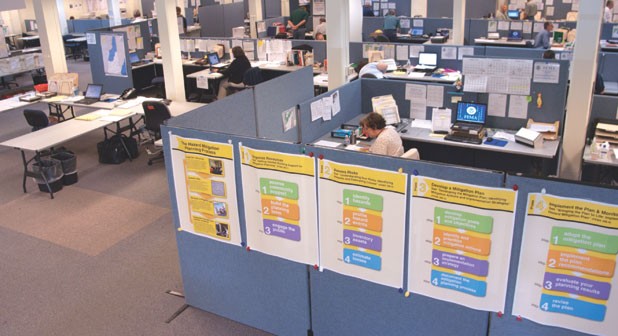
- Matthew Thorsen
- FEMA office in Burlington
In the wake of the massive spring flooding that devastated parts of Vermont, President Obama designated seven counties in the state as “disaster areas.” Thousands of affected residents and business owners welcomed the news on June 15. Since then, Vermont media have been receiving almost daily updates from the Federal Emergency Management Agency about the speedy progress of its disaster-response workers.
Most of the 150 FEMA workers currently deployed in Vermont operate out of its statewide headquarters, which take up two floors of the Innovation Center of Vermont in Burlington’s South End. The 23,640-square-foot office space, which rents for $40,000 a month, once housed the armaments and technical products division of General Dynamics.
The Burlington Joint Field Office, as it’s called, is so named because virtually every federal employee has a state counterpart.
A quick survey of license plates in the parking lot — including Alaska and Texas — suggests many of these federal agents are a long way from home. Ordinarily, Vermont-bound disaster-relief workers hail from other New England states. But the agency is stretched thin right now as a result of devastating tornadoes in the South and Midwest, floods along the Mississippi and Missouri rivers, and wildfires in the Southwest. FEMA is operating 28 joint information offices across the country like the one in Burlington.
Alan Cross, a former news and sports editor from Des Moines, Iowa, was among the first FEMA workers to hit the ground in mid-June, when the agency began scouting around for a place to set up shop. Now he’s the Burlington JFO’s official public information officer.
The former General Dynamics space was an obvious choice, Cross says of the four-story brick building on Lakeside Avenue. Access is easily controlled, with its Department of Defense-approved security system, magnetic locking doors, key cards, and scores of internal and external security cameras that can pan, zoom and record audio and video.
Although Cross downplays FEMA’s security concerns, the Chittenden County sheriff’s deputy posted at the front door makes it clear that FEMA takes nothing for granted — and for good reason. Despite the agency’s humanitarian mission, not everyone views post-Katrina FEMA favorably. One need only Google “FEMA” to discover scads of pages devoted to “X-Files”-like conspiracy theories, peddled by such people as Jesse Ventura and Michele Bachman, about FEMA-run concentration camps and shadow military governments.
Once inside, however, the place looks more like a motor-vehicles bureau than a secret police command post. Hallways and cubicles once adorned with posters of Gatling guns and antiaircraft ordnance now display floodplain maps, newspaper clippings and gravel-road stabilization plans. Near the front door is a table explaining the workings of “non-woven continuous filament heat-bonded polypropylene geotextiles” — aka erosion-control devices.
Also like a DMV office, the place is replete with cubicles and overhead signs indicating departments of “mitigation,” “public assistance,” “external affairs,” “internal security” and so forth. There’s even an “alternative dispute resolution” office, just in case a disgruntled FEMA employee can’t get along with his or her coworkers.
Why are so many FEMA workers still needed in Vermont? As Cross explains, three additional Vermont counties — Washington, Orange and Essex — were approved last month for federal assistance. That means community-relations workers — the people who knock on doors and help flood victims apply for federal grants — are fanning out across the state to take aid applications.
Cross says many Vermonters, including some who suffered major losses, are surprised the agency is still around. “Vermonters are very self-sufficient,” Cross says. “They’re the types that say, ‘Well, I got hit, but I can fix it myself.’”
Not everyone is so stoic, however. As of August 4, nearly 1600 Vermonters had been approved for more than $3.5 million in individual disaster aid. That doesn’t include another $7.5 million that FEMA expects to spend on flood-mitigation projects for municipalities.
Additionally, the U.S. Small Business Administration has OK’d at least 58 low-interest loans totaling more than $1.2 million. In all, the Burlington Joint Field Office estimates its presence will have a total economic impact of $30 million in Vermont.
The opportunities won’t last forever. August 15 is the deadline for Vermonters to register for assistance in Addison, Chittenden, Essex, Franklin, Grand Isle, Lamoille and Orleans counties; for Washington and Caledonia counties, it’s September 6. After those dates, FEMA will start “demobing,” or demobilizing, its operations and sending its employees home or to other disasters.
From the looks of its digs, FEMA isn’t going anywhere too fast. But, as one employee put it, “Almost from the first day we arrive, we develop an exit plan.”
Cross concurs. “FEMA really is a good steward of taxpayers’ money,” he says. “The saying is, we work ourselves out of a job.”










Comments
Comments are closed.
From 2014-2020, Seven Days allowed readers to comment on all stories posted on our website. While we've appreciated the suggestions and insights, right now Seven Days is prioritizing our core mission — producing high-quality, responsible local journalism — over moderating online debates between readers.
To criticize, correct or praise our reporting, please send us a letter to the editor or send us a tip. We’ll check it out and report the results.
Online comments may return when we have better tech tools for managing them. Thanks for reading.